The Biblical Exodus – Plagues & Celestial Upheaval
The Biblical Exodus is one of the most pivotal narratives in the Hebrew Bible, recounting the liberation of the Israelites from Egyptian bondage under the leadership of Moses. This event, central to Jewish identity and theology, is detailed primarily in the Book of Exodus, the second book of the Torah.
According to the biblical account, the Israelites, descendants of Jacob, had settled in Egypt during a famine and were subsequently enslaved by a pharaoh who "knew not Joseph" (Exodus 1:8). The Exodus story begins with Moses, chosen by God to confront Pharaoh and demand the release of His people. When Pharaoh refuses, a series of ten plagues are unleashed upon Egypt, each demonstrating the power of the God of Israel over the Egyptian pantheon.
The ten plagues, as described in Exodus 7–12, include the turning of the Nile to blood, infestations of frogs, lice, and flies, the death of livestock, boils, hail, locusts, darkness, and finally, the death of the firstborn. These plagues are not merely acts of divine retribution but are deeply symbolic, targeting Egyptian deities and the natural order they were believed to govern.
The final plague, the death of the firstborn, leads to the institution of Passover, a ritual commemorating the Israelites' deliverance as the angel of death "passes over" their homes marked with lamb's blood. Following this, Pharaoh relents, and the Israelites depart Egypt, culminating in the miraculous crossing of the Red Sea, where the pursuing Egyptian army is drowned.
Dating the Exodus: Archaeological Perspectives
The historicity and dating of the Exodus have been subjects of extensive scholarly debate. The Bible does not explicitly name the pharaoh of the Exodus, complicating efforts to anchor the event in a specific historical period. Traditional biblical chronology, based on internal timelines such as 1 Kings 6:1, places the Exodus around 1446 BC, during the reign of Thutmose III or Amenhotep II of the 18th Dynasty. However, many scholars argue for a later date, circa 1250 BC, during the reign of Ramses II, aligning with the mention of the city of Ramses in Exodus 1:11.
Archaeological evidence for the Biblical Exodus remains elusive. The absence of direct textual or material evidence from Egyptian records has led some researchers, such as William Dever and Israel Finkelstein, to question the event's historicity as described in the Bible. Others, like Kenneth Kitchen, argue for a more nuanced interpretation, suggesting that the Exodus may reflect a smaller-scale event or a conflation of historical memories.
The Biblical Exodus: A
Very Real Event
Now it should come as no surprise to find that this present researcher absolutely believes that the Exodus was a very real historical occurrence. Not merely symbolic or metaphorical. Moreover, that the listed catastrophic events associated with it were triggered by a special planetary alignment. This indeed being the very key to dating it.
All of the various plagues listed in the Bible were effectively the result of celestial upheaval. Essentially, a pollution of the Earth’s atmosphere from space. The Earth itself being caught up in a cometary stream. And not via some unknown body either, but rather a stream centred upon one of the inner planets i.e. Mercury or Venus.
To be sure, when great conjunction patterns occur marking the end of one world age and the beginning of another, certain planets within the solar system are capable of temporarily developing cometary properties. Something well noted even by Immanuel Velikovsky.
The Exodus Pharaoh & The Great Comet
Concerning when the Biblical Exodus event is said to have occurred, two proposed dates dominate within academia. One is near the midpoint of the 15th century BC (1446 BC), in accordance with the biblical reference: 1 Kings 6:1. The other is much later, close to the midpoint of the 13th century BC. Of the two dates, it would appear that the former is far closer to the truth; two decisive references providing powerful support.
1) The first support point concerns an ancient reference to a great comet sighted in the sky during the reign of Thutmose III:
‘This comet was recorded by the Egyptians in the 22nd year of the reign of the pharaoh Thutmose III, who described it as a brilliant disc much larger than the full moon, adding that it was a “marvel never before known since the foundation of this land, [Egypt]” Chinese astronomers, who meticulously recorded celestial occurrences for astrological purposes, also noted the breath-taking event. The ancient Mawangdui, Silk Almanac, preserved in the Hunan Provincial Museum of Changsh, depicts the comet as one of the largest ever observed. Not only did it fill a large part of the sky, it had an astonishing ten tails. (The biggest comet observed since the birth of modern astronomy. De Cheseaux’s Comet of 1744 AD had only Seven)’
Ancient Origins Website, Graham Phillips (5 October 2016)
With this reference in hand, one must then ask just when the reign of Thutmose III actually began, which would fix the year of the 22nd year of his reign, and thus the year of the comet. According to the relevant scholars, the generally accepted date for when Thutmoses’ reign began was 1479 BC. According to the Wikipedia article on the pharaoh in question:
‘Thutmose III (sometimes read as Thutmosis or Tuthmosis III, Thothmes, in older history works, and meaning “Thoth is born,”) was the sixth Pharaoh of the 18th Dynasty. Thutmose III ruled Egypt for almost 54 years and his reign is usually dated from 24 April 1479 BC to 11 March 1425 BC, from the age of two and until his death at the age 56. However, during the first 22 years of his reign, he was co-regent with his stepmother and aunt, Hatshepsut, also named pharaoh.’
It is interesting that in the Wikipedia citation, Thutmose III is a co-regent with his aunt for the first 22 years of his reign. There is no mention however of a comet in this particular article. From the cited ancient origins website passage though - another piece of the puzzle, so to speak - one would assume that the noted comet marked the end of the co-regency, along with the upheaval of the kingdom. That being the Exodus event itself.
From all of the above then, one can fix the date of the Biblical Exodus as follows:
The Exodus Date = 1479 BC + 22 years = 1457 BC
2) It is well to note that one can arrive at this very same date with another decisive connection. Herein consider a passage from the book by Immanuel Velikovsky, Worlds in Collision (1950):
‘Anaximenes and Anaximander in the sixth pre-Christian century, and Diogenes of Apollonia in the fifth century, assumed the destruction of the world with subsequent re-creation. Heraclitus (540 BC to 475 BC) taught that the world is destroyed in conflagration after every period of 10,800 years. Aristarchus if Samos in the third century before the present era taught that in a period of 2484 years, the Earth undergoes two destructions - of combustion and deluge. The Stoics generally believed in periodic conflagrations by which the world was consumed, to be shaped anew.’
In the above passage, the critical time period of interest here is that given by Aristarchus of Samos: 2484 years. The question is, just what calendar year it hangs upon.
This is where we consider once more The Great World Age Ending Conjunction Cycle, as noted in other articles: A grand alignment involving Mars, Venus, the Sun and Mercury, along with the galactic centre. Whilst simultaneously, the Sun and the Earth are aligned with the Pleiades star group.
Reproduced below is the sequence of this rare alignment stretching back into the past, as detailed in previous articles on this website. One may note in particular the instance of the alignment highlighted in red: 3941 BC:
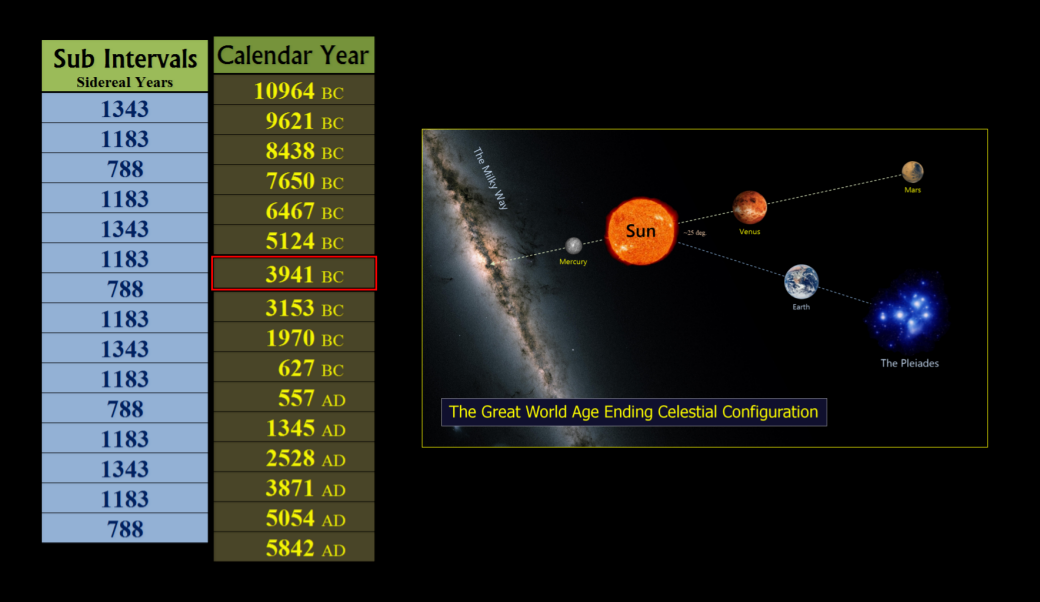
What Aristarchus of Samos is saying in the above cited passage, is that the interval of 2484 years is bounded by a destructive event at either end. Now it has previously been shown that there was indeed a sudden dramatic change to the Earth's climate circa 3950 BC. Taking this as one event, if one goes forward in time exactly 2484 years, one arrives at the exact same date as that linked to the comet of Thutmose III, given above:
3941 BC + 2484 years = 1457 BC = The Exodus Event
Here then, it is the considered opinion of this present researcher, that the precise date of the Biblical Exodus event is indeed 1457 BC. Actual confirmation of this resting upon the fact that during this very year, there is an exceptional astronomical alignment, that one cannot help but consider to be an authentic end of age conjunction, totally responsible for triggering all of the exotic destructive effects associated with the Exodus event i.e. the 10 plagues of Egypt.
The Exodus alignment of 1457 BC
If one searches the skies with the appropriate astronomical software, one particular date in the year 1457 BC stands out dramatically. This is when there is a direct four body alignment involving all of the inner planets: Mercury, Venus, the Earth and Mars.
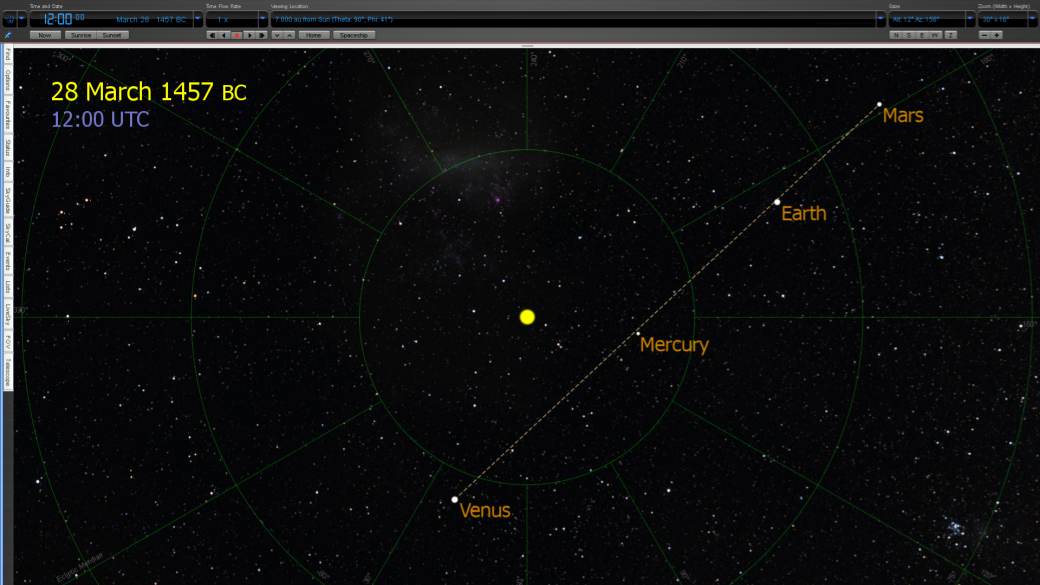
The specific date in question is 28 March 1457 BC
The alignment (above: a direct overhead screenshot from Starry Night 6.0 professional) is truly exceptional, and even more so when one considers what it is targeting. If one positions oneself at the centre of the planet Mars, looking down the line to the other bodies, one can see that the alignment is practically dead on targeting The Pleiades star group:
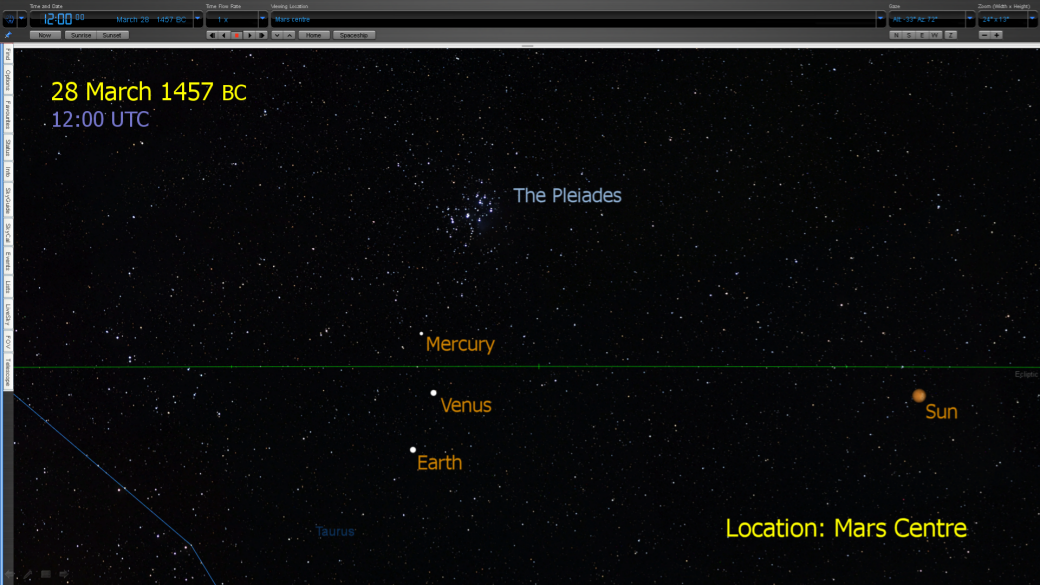
In consideration of planetary alignments actually capable of highly destructive effects, it should be noted that there are certain dangerous directions in the sky linked to individual alignments. One of the most dangerous is indeed associated with The Pleiades star group. Quite a number of special alignments that include this star group have been responsible for previous earthbound upheaval.
One prominent example of this is Noah’s Flood (2348 BC), as dealt with in a previous article on this website. This too involved a four body alignment targeting The Pleiades star group:
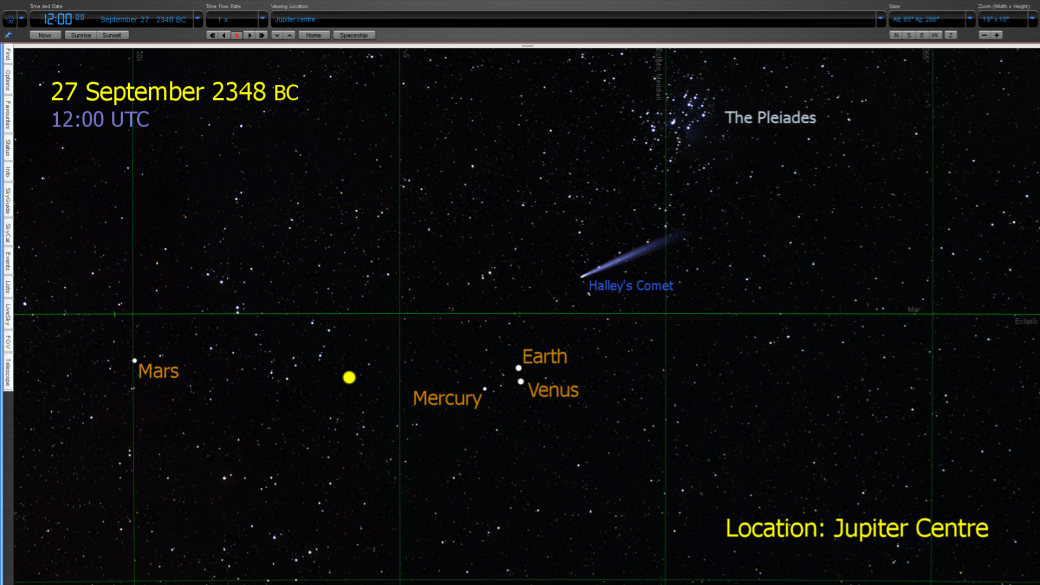
What is suggested here then, is that when the four inner planets went into alignment with The Pleiades on the 28th of March 1457 BC, this energetically excited either Mercury or Venus - probably the latter - to develop a long cometary tail. That being the comet associated with the 22nd year of the reign of Thutmose III. Moreover, that the Earth itself then passed through this tail in the course of its own orbit about the sun.
Exodus Dating: The Hebrew Calendar & Passover
As persuasive as all the evidence presented so far is, there is one additional point to note. A further connection which would appear utterly decisive in dating the Exodus event to the precise date: 28 March 1457 BC. This further proof relates to the Hebrew calendar, and how it ties into the tradition of Passover. It would be well therefore to say something about this tradition, including its origin. Here is an excerpt from Wikipedia:
Passover, also called Pesach (Biblical Hebrew: חַג הַפֶּסַח), is a major Jewish holiday and one of the Three Pilgrimage Festivals. It celebrates the Exodus of the Israelites from slavery in Egypt.
According to the Book of Exodus, God commanded Moses to tell the Israelites to slaughter a lamb and mark their doorframes with its blood, in addition to instructions for consuming the lamb that night. For that night, God would send the Angel of Death to bring about the tenth plague, in which he would smite all the firstborn in Egypt. But when the angel saw the blood on the Israelites' doorframes, he would pass over their homes so that the plague should not enter (hence the name.)
Passover starts on the 15th day of the Hebrew month of Nisan, which is considered the first month of the Hebrew year.
At its inception then, Passover involved all of the ancient Hebrews slaughtering a lamb and smearing its blood about their doorframes. And this critical action occurred on the 15th day of the month Nisan, under the Hebrew calendar.
Well indeed, there is on the Internet an excellent calendar converter to be found at the website: https://www.midrash.org/calendar/. By inputting the Julian calendar date 28 March 1457 BC, one can see it converted to the correct date under the Hebrew calendar, as shown below:
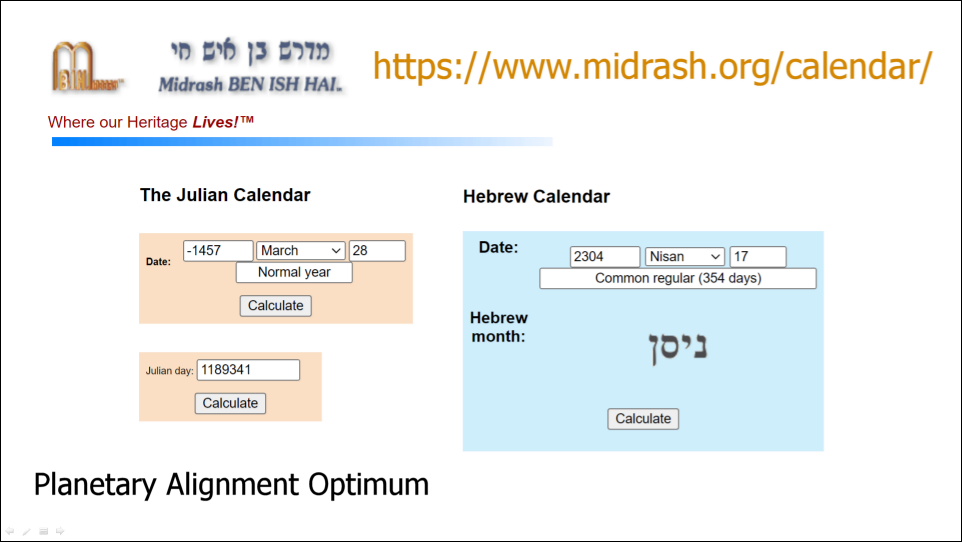
Quite remarkably, one finds that the date is 17 Nisan (year 2304) - only two days from 15 Nisan. This would place Passover, were it to occur within this year, two days earlier, on 26 March 1457 BC:
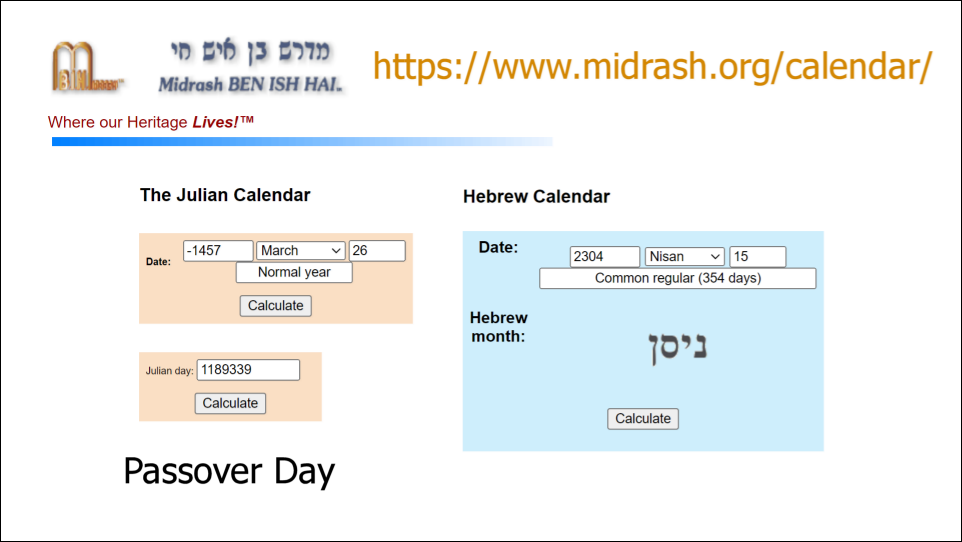
Now it is very interesting to note, that upon this date, there is something very significant happening in the heavens. This being something additional and quite separate to the optimum alignment of the previously noted four bodies (which occurs two days later).
Positioned at the centre of the sun, if one zooms in close to the Earth, one can see the moon partially obscured. In other words, there is an active lunar eclipse occurring on 26 March 1457 BC - albeit a partial eclipse.
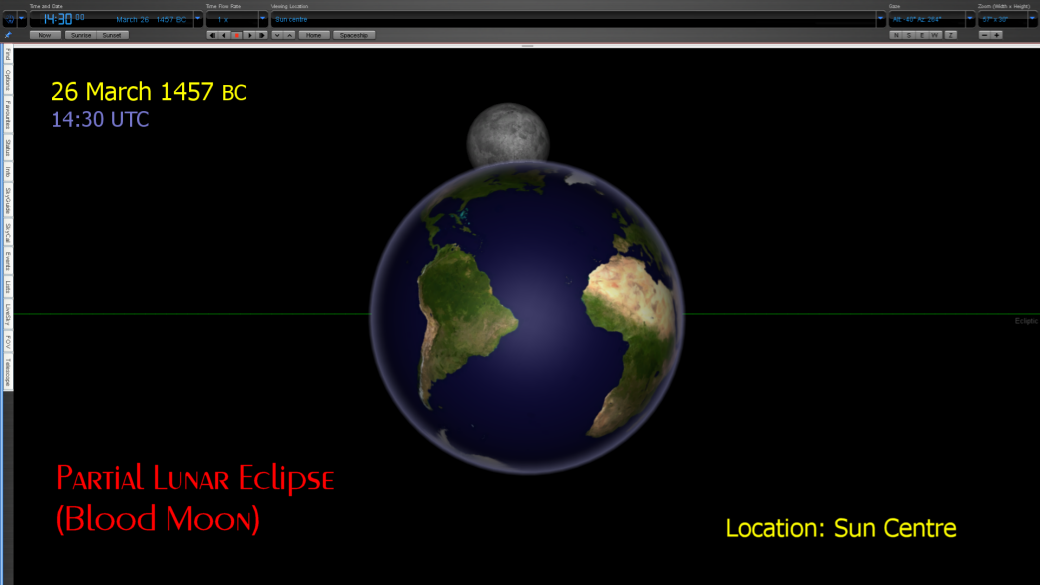
Now when lunar eclipses occur, the moon turns red in colour. Hence why they are often called blood moons.
In this case the intrigue is heightened further, when one switches position from the centre of the sun to the centre of the moon; looking back upon the earth. If in doing so, one also reveals the constellations in the sky behind the Earth and sun – now under observation – then a remarkable association is to be had.
The critical constellation just behind these two noted bodies is the constellation Aries, which is depicted as a Ram - which itself is a lamb.
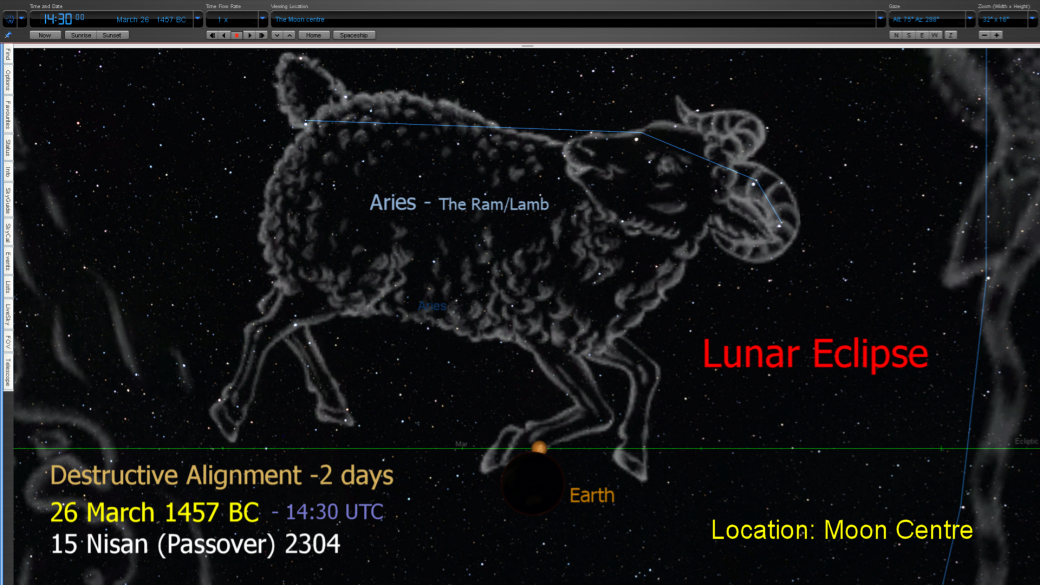
The connection is clear and undeniable:
On the very day that the ancient Hebrews all slaughtered a lamb and smeared its blood on their door frames, there was a lunar eclipse i.e. blood Moon aligned with the Aries constellation: The Ram/Lamb. All of which occurred on 15 Nisan (year 2304) under the Hebrew calendar, two days before the optimum four body planetary alignment which triggered the great catastrophe: 28 March 1457 BC - Julian calendar date.
The Passover connection would appear utterly decisive then in reinforcing the date of the Exodus event, as linked to the four body alignment. The very first Passover itself occurred two days earlier, on 26 March 1457 BC Julian Calendar / 15 Nisan 2304 Hebrew Calendar. This being the absolute start date of the tradition.
Foreknowledge of the Exodus event
In a previous article it was revealed how the ancient 819-day calendar cycle enabled one to target/forecast Noah’s Flood (of 2348 BC). Likewise, it would appear that the Biblical Exodus event itself may also have been similarly targeted. In this case using a 360-day calendar cycle, combined with a special initial adjustment of 20 days. A unit of time known to the Maya as a Uinal; being one of the five units that make up the Long Count calendar system.
Here then, one may note that just prior to the Exodus alignment of 1457 BC, the last instance of the Great World Age Ending Alignment (as detailed above, involving Mars, Venus, the Sun and Mercury, all aligned to the galactic centre + The Sun and the Earth aligned with the Pleiades), occurred in the year 1970 BC. Specifically on the 8th of October.
Using this alignment as an anchor point, if one applies an initial backwards adjustment of 20 days, one arrives at 18 September 1970 BC. From here, if one begins a 360-day calendar, then after precisely 520 such units, one will perfectly harmonise with the date of the Biblical Exodus alignment:
8 October 1970 BC – 20 days = 18 September 1970 BC
18 September 1970 BC + (360 × 520) = 28 March 1457 BC = Exodus Alignment
Such an elegant solution is highly suggestive of the fact that somebody was indeed using such a calendar during this time. Somebody fully aware of the significance of the four body alignment of 1457 BC; knowing full well that it would cause major celestial upheaval. And by actively using a 360-day calendar system to target it, they could forewarn future generations, allowing them to prepare for it.
Next: The Bronze Age Collapse
Back to: Signs of the Times Menu